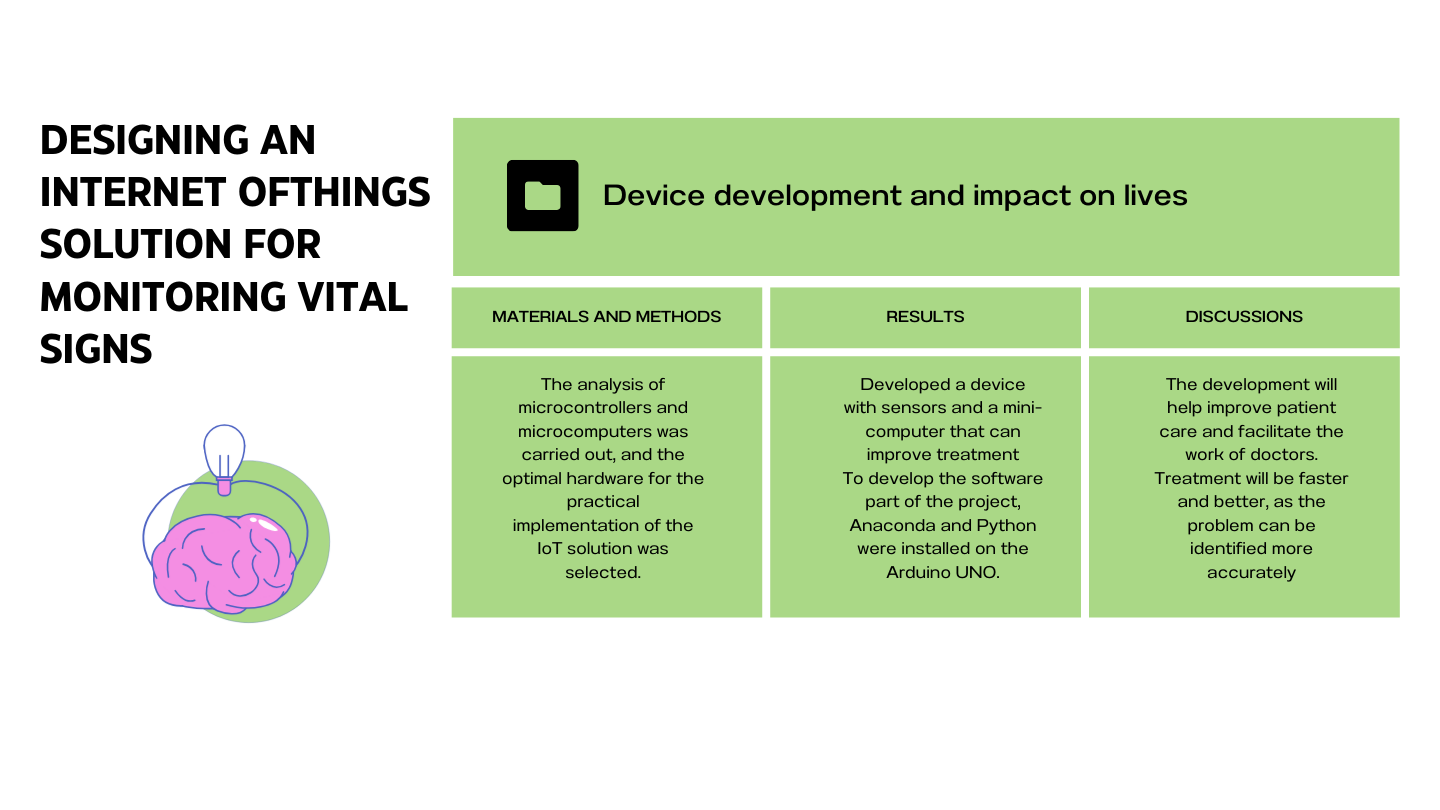Розробка рішення інтернету речей для моніторингу життєво важливих показників
DOI:
https://doi.org/10.15587/2706-5448.2024.300745Ключові слова:
моніторинг життєво важливих показників організму, клієнт-серверна архітектура, інформаційна система, інтернет речей, IoTАнотація
Об’єктом дослідження є процес моніторингу життєво важливих показників організму за допомогою автоматизованої системи на основі рішення інтернету речей (IoT). У роботі проведено дослідження та аналіз найкращих наявних рішень для безперервного моніторингу стану людини. Дослідження є важливим за умов можливої пандемії та загального огляду та контролю здоровʼя людини.
Запропоновано IoT модель рішення для моніторингу та аналізу життєво важливих показників у пацієнтів. Проєкт передбачає створення апаратного та програмного забезпечення для відстежування життєво важливих показників. Взаємодія двох частин забезпечить можливість виконання основної задачі – отримати результат та аналіз показників життєво важливих показників організму людини. Апаратне забезпечення реалізоване за допомогою пристроїв для сканування даних про пульс, температуру, сатурацію та можливість відстежування електрокардіограми. Передбачено можливість передачі даних про стан організму. Враховується положення датчиків, які прикріплені до тіла, на випадок того, якщо вони відклеються. Сам пристрій має розташовуватись на тілі людини у зоні передньої стінки грудей, зап’ястях та кісточках пацієнта. Також пристрій запрограмований реагувати на раптові перепади у значеннях даних. Програмна реалізація створена на основі веб орієнтованого інтерфейсу. Проєктування кінцевих рішень взаємодії локального та проміжного сервера було реалізовано за допомогою Django та Python. Можливість адміністрування проміжного сервера клієнтської частини було написано за допомогою HTML, CSS та JavaScript. Застосування IoT-рішення дозволяє моніторити показники життєво важливих показників організму та їх аналіз. Побудовано схему обміну інформації в системі контролю показників стану здоровʼя
Посилання
- Norav medical. Available at: https://www.noravmedical.com
- Cardiomo monitoring heart health. Available at: https://www.cardiomo.com
- Shea, S. (2018). Microcomputer. Available at: https://www.techtarget.com/iotagenda/definition/microcomputer
- Lutkevich, B. (2019). Microcontroller. Available at: https://www.techtarget.com/iotagenda/definition/microcontroller
- Raspberry Pi. Available at: https://www.raspberrypi.org
- Asus Tinker Board. Available at: https://www.asus.com/networking-iot-servers
- LattePanda. Available at: https://www.lattepanda.com
- Arduino. Available at: https://www.arduino.cc
- Google Trends. Available at: https://trends.google.com/trends/
- e-Health Sensor Shield. Available at: https://www.arrow.com/en/products/10269/libelium-comunicaciones-distribuidas-sl
- The DFRobot heart rate and oximeter sensor integrates the Maxim MAX30102 chip. Available at: https://wiki.dfrobot.com/Heart_Rate_and_Oximeter_Sensor_V2_SKU_SEN0344
- Model JP403 – Medical Temperature Sensor of Adult Body Surface. Available at: https://www.medical-xprt.com/products/model-jp403-medical-temperature-sensor-of-adult-body-surface-673919
- ECG Monitoring with AD8232 ECG Sensor & Arduino. Available at: https://how2electronics.com/ecg-monitoring-with-ad8232-ecg-sensor-arduino/
- ANACONDA. Available at: https://www.anaconda.com/
- Django framework. Available at: https://www.djangoproject.com
- Arduino Software. Available at: https://www.arduino.cc/en/software/
- SQLite. Available at: https://www.sqlite.org/index.html
- Python Developer’s Guide. Available at: https://devguide.python.org/
- What is Arduino. Available at: https://www.kanda.com/what-is-arduino.php
- Microcomputer-controlled devices for human implantation. Available at: https://secwww.jhuapl.edu/techdigest/Content/techdigest/pdf/V04-N02/04-02-Fischell.pdf

##submission.downloads##
Опубліковано
Як цитувати
Номер
Розділ
Ліцензія
Авторське право (c) 2024 Iryna Zinko, Olha Kravchenko, Dmytro Syvoglaz

Ця робота ліцензується відповідно до Creative Commons Attribution 4.0 International License.
Закріплення та умови передачі авторських прав (ідентифікація авторства) здійснюється у Ліцензійному договорі. Зокрема, автори залишають за собою право на авторство свого рукопису та передають журналу право першої публікації цієї роботи на умовах ліцензії Creative Commons CC BY. При цьому вони мають право укладати самостійно додаткові угоди, що стосуються неексклюзивного поширення роботи у тому вигляді, в якому вона була опублікована цим журналом, але за умови збереження посилання на першу публікацію статті в цьому журналі.








